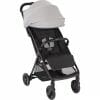Parenting
Hair Maintenance Tips For Black Or Multiracial Infants
Perform a swift internet search on “how to cleanse and style my infant’s hair,” and you’ll discover numerous outcomes that could consume your entire weekend. Personally, I delved deeply into this matter before and after my son’s arrival, focusing specifically on hair maintenance strategies for Black or multiracial infants.
During my eighth month of pregnancy, I underwent an ultrasound where the doctor mentioned glimpsing my baby’s hair in the images. Unbeknownst to me then, this indicated that he was blessed with a voluminous head of hair. Even today, the most frequent observation about my son is his abundant hair. I am enamored by the fact that he was born with natural curls, but I lacked knowledge on how to properly care for his precious locks.
Having had long curly hair myself (up until a few months ago when I had a drastic haircut), I have been persistently experimenting with various techniques and hair care products. Curly hair demands consideration for factors like curl pattern, porosity, thickness, as well as the moisture levels of the scalp. These elements play a crucial role in determining the most suitable hair care routine. Understanding these aspects of your natural hair assists in identifying the appropriate products for your unique hair type.
However, how does one approach this when dealing with an infant whose curl pattern is yet to fully manifest, and one must steer clear of any chemicals or strong scents? Furthermore, when you initiate the aforementioned search query, the majority of the results cater to hair care for white infants—it necessitates an extensive search to uncover information pertaining to Black or multiracial infant hair care.
After conducting extensive research and seeking advice from fellow mothers of infants of color, I’ve gleaned five crucial insights regarding the care of my infant’s hair—peruse them below.
5 Hair Maintenance Tips for Black or Multiracial Infants
1. Limit Washing to Once a Week
Individuals of Color often have dry scalps and require additional moisture for healthy hair. Daily hair washing for your infant could lead to the removal of essential oils, resulting in brittle and dry hair. Initiate a weekly hair washing routine initially and consider increasing it to twice a week if you observe quicker oil buildup.
2. Opt for Natural Moisturizers Over Elaborate Products
In conjunction with the above dry scalp advice, post-washing, it’s crucial to rehydrate your infant’s hair with oils and moisture. While the market offers a plethora of infant products, it is advisable to refrain from them until your infant is a bit older. From birth, leveraging basic, natural elements like coconut, avocado, or almond oil proves to be the most advantageous. Simply dispense a small amount into your palm and gently apply it to your infant’s hair using your fingers.
3. Use Your Fingers for Combing Curls
If your little one has curly hair, you must have faced challenges in detangling those adorable curls. Instead of a wide-tooth comb, opt for running your fingers through your baby’s hair. This method is effortless and helps maintain their natural curl pattern.
4. Choose Fabrics Wisely
Black babies’ hair texture makes it vulnerable to dryness, brittleness, and breakage when exposed to fabrics like cotton or wool. To prevent this, opt for hair wraps, hats, scarves, pillowcases with satin or silk linings. These fabrics are softer and help retain moisture in the hair rather than absorbing it.
Editor’s Note: Remember to adhere to safe sleeping practices when introducing pillows or similar accessories to your infant’s bed. According to the American Academy of Pediatrics’ safe sleep guidelines, babies should sleep on a firm, flat surface free of pillows, blankets, and other soft bedding until at least age 1.
5. Embrace Your Baby’s Natural Hair
In various media platforms, you might predominantly see babies with fine, silky, or straight hair, which can be frustrating. This lack of representation can mirror your own challenges in finding similar hair types, from your past long curls to your current short style. It’s human nature to seek familiarity in others, and the same applies to our babies’ hair.
Therefore, encourage yourself to embrace your baby’s inherent hair qualities and invest time in understanding how to care for and style it. Although your baby’s hair texture may differ from your own or what’s commonly portrayed, enjoy the journey of experimentation to discover what best suits your baby’s unique hair type.
Nurturing a baby with naturally curly, wavy, or kinky hair may involve extra effort, and the consistency of curls may vary daily, but by showing love for your baby’s natural hair, you set a positive example for them to cherish it too.

















